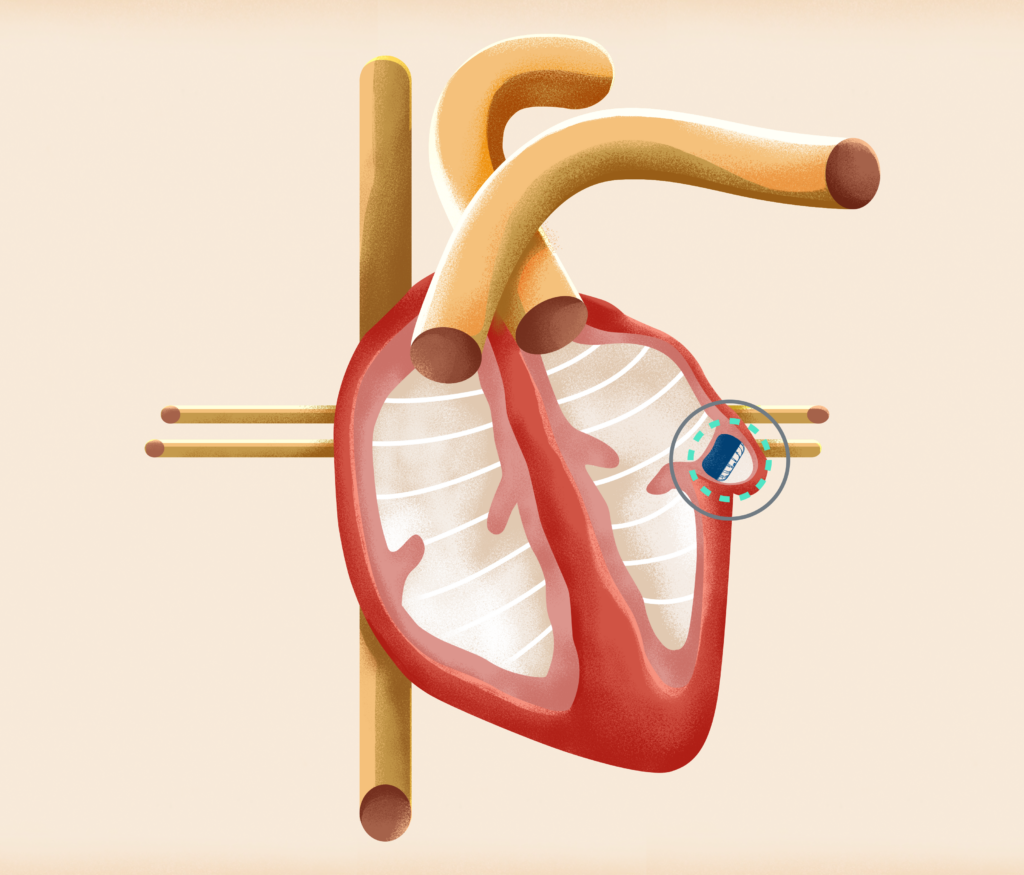WATCHMAN: A One-Time Implant that Helps Reduce AFib Stroke Risk
How Does AFib Increase Stroke Risk?
The average person with atrial fibrillation (also called AFib or AF) is five times more likely to have a stroke than someone with a regular heartbeat. That’s because AFib can decrease the heart’s pumping capacity. Therefore, blood isn’t pumped out of the heart normally, making it easier for blood cells to stick together and form clots in an area of the heart called the left atrial appendage (LAA). When a blood clot escapes from the LAA and travels to another part of the body, it can cut off the brain’s blood supply, causing a stroke.

In people with atrial fibrillation not caused by heart valve problems (the most common type of AFib), more than 90% of stroke-causing clots that come from the heart are formed in the LAA.
Learn more about atrial fibrillation and stroke risk.
Reducing AFib Stroke Risk
Blood thinners, also called anticoagulants, are an effective way to lower stroke risk in people with atrial fibrillation not caused by heart valve problems. Common blood thinners include warfarin (also known as Coumadin®), Eliquis®, Pradaxa®, Xarelto®, and Savaysa®.
However, some people need an alternative to blood thinners because they can increase bleeding risk. Some bleeding events are minor and easily treated, like a cut taking longer than normal to stop bleeding. In other cases, the bleeding can be life-threatening, such as when bleeding in the brain causes a stroke.
If you have a history of bleeding or a lifestyle, occupation, or condition that puts you at risk for bleeding, your doctor may consider an alternative to blood thinners, such as the WATCHMAN or WATCHMAN FLX™ Implant.
An Alternative to Blood Thinners
WATCHMAN is a one-time, minimally invasive procedure for people with atrial fibrillation not caused by a heart valve problem (also known as non-valvular AFib) who need an alternative to blood thinners. It’s about the size of a quarter and made from very light and compact materials commonly used in many other medical implants.
At Southcoast Health, hundreds of patients have left blood thinners behind with WATCHMAN.
How WATCHMAN and WATCHMAN FLX™ Works
Normally, when the heart contracts, it squeezes blood from the left atrium and LAA into the left ventricle. In AF patients, contraction in the left atrium doesn’t happen effectively, and blood pools in the LAA – where it can form clots. The clot can become displaced and travel to the brain, causing a stroke.
The WATCHMAN Implant fits right into your LAA. It’s designed to permanently close it off and keep those blood clots from escaping.

At Southcoast Health, the cardiovascular team performs the WATCHMAN procedure in Fall River, MA, for our AF patients. The procedure is performed by Dr. Ramin Davoudi, Dr. Adam Saltzman, and Dr. Nitesh Sood. Under advanced 3D echocardiographic guidance, the procedure is provided by Dr. Christopher Abadi, Dr. Albert Lin, and Dr. Robert Vazquez.
Southcoast Health is always looking for ways to make effective treatments even better. WATCHMAN is no exception. Now, we offer the WATCHMAN FLX – an advancement that enables the implant to fit a greater number of patients, giving more people than ever a safe, effective alternative to blood thinners should they need one.
How is WATCHMAN Implanted?
WATCHMAN is implanted into your heart in a minimally invasive, one-time procedure. To implant WATCHMAN, your doctor makes a small cut in your upper leg and inserts a narrow tube, as done in a standard stent procedure. Your doctor then guides WATCHMAN into your heart’s LAA. The procedure is done under general anesthesia and takes about an hour. Patients commonly stay in the hospital overnight and leave the next day.

After the Procedure
Following the WATCHMAN procedure, your doctor will prescribe you blood-thinning medication for 45 days or until your LAA is permanently closed off. During this time, heart tissue will grow over the implant to form a barrier against blood clots. Your doctor will monitor this process by taking pictures of your heart to see when you can stop taking your blood thinners.
In a clinical trial, 96% of people were able to stop taking blood thinners just 45 days after the WATCHMAN procedure.
Is WATCHMAN Right for You?
If you have a history of bleeding or a lifestyle, occupation, or condition that puts you at risk for bleeding, WATCHMAN may be right for you. Reach out to your primary care physician or our cardiovascular team to learn more.
Southcoast Health provides the WATCHMAN procedure in Fall River, MA at, Charlton Memorial Hospital.
